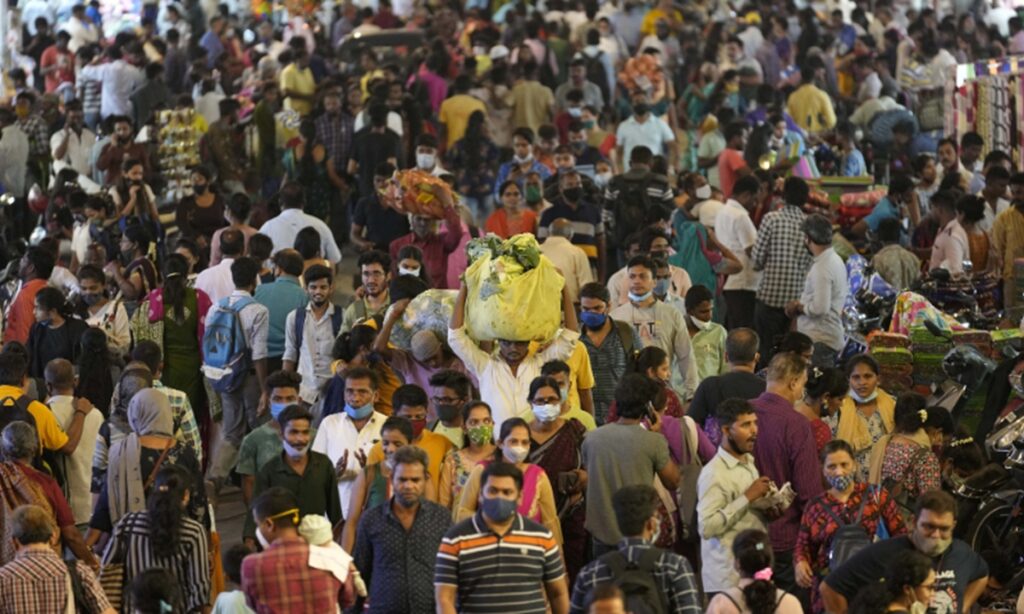India is expected to surpass China by mid-2023 as the world’s most populous nation, data released by the United Nations showed on Wednesday, again raising discussions as to whether the booming Indian population could help the South Asian nation become a potential manufacturing hub that will be on par with, if not replace, China’s manufacturing industry.
However, a mere growth in population size does not guarantee anything. Indeed, the past decades saw India as the world’s second most populous nation, but that didn’t give it much of a boost to its domestic manufacturing development, and it wasn’t until recent years that India’s population has been considered as a potential driver fueling its economic growth.
Against the background of the US’ “decoupling” push from China and a restructuring trend in global industrial chains, Western media outlets have dramatically intensified their hype about the so-called demographic dividend in India, with the clear intention of pushing global supply chains away from China. The hype also caters to the desire of the Modi government to mobilize its large working-age population to develop domestic manufacturing and boost India’s economic growth.
There is no denying that India does have huge advantages in terms of demographic conditions. Data from the Pew Research Center showed that people under the age of 25 account for more than 40 percent of India’s population, and roughly one-in-five people globally who are under the age of 25 live in India. Also, India’s median age is 28, much younger compared with 38 in the US and 39 in China. India’s working-age population is forecast to hit more than 1 billion over the next decade, according to the Indian government.
On the surface, it seems that with its huge and young population, India does have the potential to become the next big economic power after China to see rapid economic growth and may even be able to compete with China in the low- and medium-end manufacturing sector in the medium and long run.
But the question is whether population alone can help India achieve its ambition of becoming a manufacturing power. There are clearly huge uncertainties. This is because potential demographic advantage does not automatically translate into a demographic dividend, nor can it translate into manufacturing development if India cannot address the challenges such as a poorly educated workforce and an unbalanced employment structure.
One of the most intuitive indicators that can gauge whether the demographic dividend has been in full play is India’s labor force participation rate, which is much lower compared with China’s. The labor force participation rate in China was 68 percent in 2021, while the rate in India was around 40 percent in 2022. In particular, India’s female work participation rate was just 25 percent for 2021, among the lowest for emerging economies, according to Reuters.
That means more than half of India’s 900 million working-age population are unemployed. On the one side, the Indian government is unable to create enough jobs to accommodate such a large work force. India’s economic growth has been mainly driven by its services sector, which accounts for more than half of the economic output but employs only 28 percent of the country’s workforce.
On the other hand, a large portion of India’s working-age population doesn’t possess the education and training needed for manufacturing jobs that require technical skills. Due to wealth inequality, gender discrimination, caste discrimination, and technological barriers, India’s illiteracy rate is relatively high, contributing to the largest population of illiterate adults, with the education level among female population being especially low. Also, since a college education does not match the skills employers need, a large number of graduates cannot find a job.
By comparison, back in 1949, China’s illiteracy rate was 80 percent, which decreased to less than 4 percent in 2021 after decades of efforts. The progress is sufficient to indicate why India can hardly undertake relocation of industrial chains from China.
Moreover, India’s protectionist policies have made it difficult for its mass-employment, labor-intensive manufacturing industries to achieve substantial development.
Fundamentally speaking, as India adds 12 million people to the working-age population every year, if it cannot improve the quality of the workforce and create enough jobs, the so-called demographic dividend could become a demographic disaster.
(Global Times)




